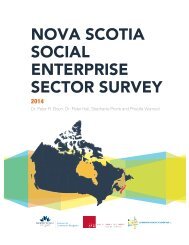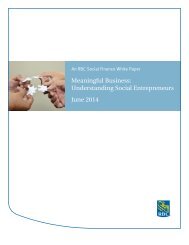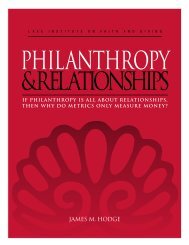Accelerating our Impact: Philanthropy, Innovation and Social Change
You also want an ePaper? Increase the reach of your titles
YUMPU automatically turns print PDFs into web optimized ePapers that Google loves.
<strong>Accelerating</strong> <strong>our</strong> <strong>Impact</strong>: <strong>Philanthropy</strong>, <strong>Innovation</strong> <strong>and</strong> <strong>Social</strong> <strong>Change</strong> The J.W. McConnell Family Foundation<br />
What are a few of the implications<br />
of the panarchy model for funders?<br />
Different skills for different stages<br />
<strong>Social</strong> innovations like PLAN typically evolve through the birth of ideas, consolidation,<br />
creative destruction <strong>and</strong> renewal (the fallow period during which new ideas are<br />
germinated). They are in a continual process of evolution, as contexts <strong>and</strong> strategies<br />
change. <strong>Change</strong> <strong>and</strong> even “creative destruction” are not to be resisted, but embraced:<br />
they n<strong>our</strong>ish innovation <strong>and</strong> are crucial to sustainability as long as there is a sense of<br />
progress.<br />
At each stage <strong>and</strong> in each of the panarchy quadrants, different skills (<strong>and</strong> perhaps<br />
different people) will be required. For instance, the creative genius behind a new initiative<br />
may not be the best person to lead the growth stage; those who value stability<br />
will not be comfortable in the uncertain environment of both endings <strong>and</strong> beginnings;<br />
<strong>and</strong> so on. Innovators <strong>and</strong> their supporters can benefit from positioning themselves<br />
accordingly.<br />
A place in the life cycle for all funders<br />
Funders can also work together to support promising initiatives through these<br />
various stages <strong>and</strong> thus “share the risk.” Community foundations, for example, are<br />
often early funders of promising local innovations. They may then turn to national<br />
or regional funders to increase the innovation’s reach <strong>and</strong> impact beyond the<br />
community of origin.<br />
Consider exit strategies<br />
One challenge for funders is to allow organizations or initiatives to come to a natural<br />
end (“creative destruction”) so that new ideas or entities can emerge. Many of us are<br />
justly accused of funding innovations only to ab<strong>and</strong>on them once they have been<br />
tested in order to pursue the next great idea; but we are equally guilty at times of<br />
propping up organizations or ideas well beyond their natural life cycles. An<br />
innovation may need in fact to be taken apart – to be “creatively destroyed” – in order<br />
to be re-assembled at another level, for example when it is being disseminated <strong>and</strong><br />
applied in a different context.<br />
Having the room to experiment is vital. Funders need to be mindful of their role <strong>and</strong><br />
work closely with organizations to determine both support <strong>and</strong> exit strategies.<br />
Important questions to ask include:<br />
Although funders are typically more comfortable in the front loop of the S curve (the<br />
birth, growth <strong>and</strong> maturity of organizations <strong>and</strong>/or ideas), they can enter into this<br />
process at any point. Some, less amenable to risk, will choose to support initiatives<br />
that are at the stage of consolidation; that is, they are already tested <strong>and</strong> ready for<br />
larger scale implementation. At this point, predictability, systems, accountability <strong>and</strong><br />
so forth become essential to rolling out programs <strong>and</strong> services in order to reach large<br />
numbers of citizens. Other funders will want to invest in research <strong>and</strong> development –<br />
the generation of ideas (“renewal”). Still others such as venture philanthropists<br />
may want to step in just as ideas are ready to be turned into prototypes (moving into<br />
consolidation). And some may want to follow <strong>and</strong> support an entire cycle.<br />
• At what point in its life cycle is an organization,<br />
a leader or an initiative?<br />
• What skills <strong>and</strong> supports will they need as they shift<br />
from one stage to another?<br />
• Why, when <strong>and</strong> how do we wind down <strong>our</strong> support?<br />
• How can we enlist the help of others who might be better suited<br />
for a group’s emerging challenges <strong>and</strong> opportunities?<br />
18<br />
19







